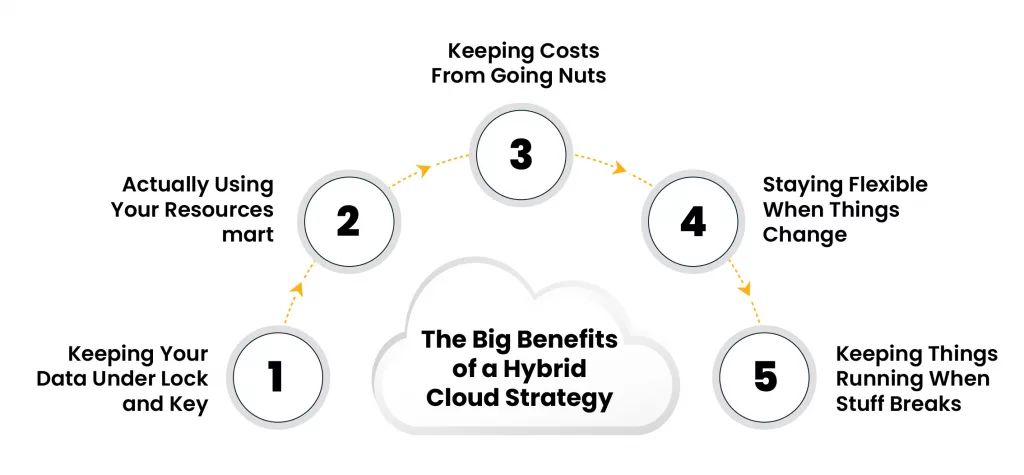Today, 64% of companies handle a minimum of one petabyte of data, and 41% of companies go even further, managing over 500 petabytes.
As a matter of fact, that’s a huge volume to handle, and it keeps growing.
Data’s exploding everywhere, and security? Well, that’s getting tougher too. Companies can’t just wing it anymore when it comes to managing their tech infrastructure. That’s where a hybrid cloud strategy comes in. You get better control, more flexibility, and way stronger security.
Most companies are already juggling multiple cloud services. But here’s the thing—without a solid plan:
- Everything becomes a complete mess
- Money starts flying out the window
- Your data ends up all over the place
On the flip side, when you’ve got a proper hybrid cloud strategy in place, things actually work.
What Is a Hybrid Cloud Strategy?
A hybrid cloud strategy is basically your using both private and public clouds together. It defines which tasks go where, how everything connects, and how you keep your data.
Why Is Hybrid Cloud Gaining Popularity?
Companies are finally figuring out that one-size-fits-all cloud solutions just don’t cut it anymore. Some stuff needs Fort Knox-level security. Other things need to be lightning fast. A hybrid approach lets you run your sensitive operations on private infrastructure while still tapping into public cloud services when you need to scale up fast.
Take healthcare companies, banks, or law firms—they’ve got crazy strict rules about data privacy. But they also need cloud access for working together, running AI stuff, or supporting global apps. A hybrid setup helps them keep their data safe.
The Big Benefits of a Hybrid Cloud Strategy

1. Keeping Your Data Under Lock and Key
When you’re dealing with sensitive stuff—customer info, health records, financial data—you need to know exactly where it is stored. With a hybrid setup you can:
- Keep regulated data on your own turf or in a private cloud
- Let public cloud handle the everyday apps and customer-facing stuff
- Makes hitting compliance targets like HIPAA, PCI-DSS, or local data laws way easier
2. Actually Using Your Resources Smart
Not every workload needs the same treatment. Some apps go crazy during business hours. Others just run occasionally for reports or batch stuff.
- Use your private setup for the steady, predictable work
- Assign the temporary or scalable jobs into public cloud so you don’t buy too much infrastructure
- Scale back automatically when you’re not using resources to save some cash
3. Keeping Costs From Going Nuts
Public cloud bills can get out of hand really fast if you’re not watching. Hybrid cloud strategies help keep spending in check by putting the right work on the right platform.
- Keep your core systems in-house to avoid those variable bills
- Move seasonal traffic or development work to public clouds
- Use cloud cost tools to catch spending that doesn’t make sense
Like, instead of paying 24/7 for cloud time on a test app, just run it in the public cloud during work hours.
4. Staying Flexible When Things Change
Business priorities shift all the time—market changes, company grows, and more. But you can stay afloat when you:
- Launch new apps in public cloud without messing up your backend
- Keep supporting old or licensed software on private infrastructure
- Skip the massive migrations by moving workloads gradually when you’re ready
This approach lets your teams move fast without taking huge risks with systems that already work.
5. Keeping Things Running When Stuff Breaks
Downtime costs money. A hybrid cloud strategy makes everything more reliable and tough. You can:
- Back up systems across different cloud environments
- Use geo-redundant storage or disaster recovery across multiple providers
- Set up failover so if one system fails, traffic automatically switches
When your main server goes down, a backup system somewhere else can take over without missing a beat.
Common Challenges to Watch Out For
1. Managing Multiple Environments Gets Complicated
More environments mean more moving parts. Without the right tools, things slip through the cracks.
- Teams might use different platforms, making it hard to see the big picture
- Alerts, metrics, and logs might live in separate places unless you bring them together
So, use centralized dashboards (Datadog, New Relic, Prometheus/Grafana work great) to track performance, uptime, and security across everything.
2. More Infrastructure, More Security Headaches
More infrastructure equals more ways for cyber attacks. Hybrid setups expand your attack surface if you’re not careful.
- Apply the same security rules everywhere—public and private clouds
- Use identity and access management through Azure AD, Okta, or AWS IAM
- Encrypt everything—data moving around and data sitting still
Regular pen tests and automated security checks help catch configuration mistakes before they become real problems.
3. Old Apps Don’t Always Play Nice
Legacy systems can be stubborn about cloud environments.
- Some old apps need super-fast access to on-premise databases or specific hardware
- Licensing rules might prevent moving certain software to cloud
Before moving anything, do a cloud-readiness check. Tools like Azure Migrate or Google’s Migration Center spot compatibility issues early.
4. Getting Stuck With One Vendor
Relying too much on one provider limits your options down the road.
- Cloud-specific tools like Lambda or BigQuery tie you to particular platforms
- Rewriting code to switch providers gets expensive and takes forever
Avoid this by:
- Building with containers or Kubernetes to keep things portable
- Sticking to open standards when you can
- Using a hybrid multicloud strategy that spreads risk and gives you negotiating power
Why a Hybrid Multicloud Strategy Makes Even More Sense
A hybrid multicloud strategy takes things further by using multiple public cloud providers plus your private infrastructure. This gives you even more flexibility.
You can put different workloads wherever they work best—Microsoft Azure, Amazon Web Services, Google Cloud, and others. It cuts down on vendor dependence and lets you negotiate better deals or use unique features from each platform.
Plus, it adds another safety net. If one provider has issues, others can pick up the slack. That’s huge for global operations or businesses that need to be up 24/7.
Who Should Think About Hybrid Cloud?
Businesses handling sensitive info—like banks, hospitals, or government contractors—are often first to use an enterprise hybrid cloud strategy.
Why? Because;
- They need tight security and strong compliance.
- Downtime isn’t an option.
But it’s not just for them. If you’re growing fast and still running old systems, you need to rethink your setup. It’s worth looking into what an enterprise hybrid cloud strategy can really offer, if you:
- Want cost control?
- Building new apps?
- Need flexibility?
What’s Coming Next in Hybrid Cloud
How businesses use cloud services keeps changing. You’ve got to stay flexible with your strategy—that’s the real trick. Everyone wants the following:
- More automation
- Smarter data handling
- Tools that actually integrate across platforms
When you’ve got a flexible cloud setup already in place, jumping on these new technologies becomes way less painful when they inevitably become table stakes.
Organizations putting money into thoughtful, well-structured hybrid cloud strategies right now are positioning themselves perfectly for whatever curveball the tech world throws next.
Summing Up!
Here’s the thing—a hybrid cloud strategy goes way beyond just picking the right tech stack. It’s really about how you run your business.
It changes everything:
- Team workflows
- Response times
- Data protection levels.
You won’t find some magic formula that works for everyone, but when you plan it right, you end up with infrastructure that grows with you while keeping everything locked down.
Looking to slash expenses? Need to satisfy regulatory requirements? Planning for serious long-term expansion? Then putting your energy into hybrid cloud strategies isn’t just smart—it’s essential.










